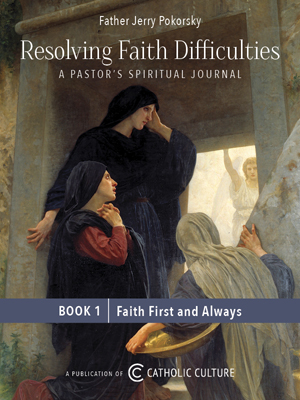Gertrude: The Only Female Saint to Be Called 'The Great'
by Paolo Rossi
Gertrude of Helfta was a highly intelligent woman. She was born on 6 January 1256 in the little town of Eisleben in Thuringia. At age 5, Gertrude went to the Cistercian monastery school of Helfta in Saxony, and since then has always been known as "Gertrude of Helfta". She dedicated herself to study, and it was not long before she surpassed all her companions.
She also discovered Christ in the monastery, and the beauty of living for him and with him in the intimacy of love. But the divine Teacher remained in the background of her life for some time while she used all her faculties to improve her education, becoming proficient in literature, philosophy, song and the refined art of miniature painting.
After several years, Gertrude moved from the monastery school to the novitiate, taking the veil and becoming a nun. For her Jesus was "Someone", but her studies were still her all. But she was not on the wrong track, for knowledge, when it goes hand in hand with humility, does not distance people from God. And he was waiting on her path.
Experiencing a 'new birth'
In 1280, she was 24 years old and a half-hearted and distracted nun. Towards the end of the year, she went through an inner crisis that lasted several weeks. She felt lonely, lost and depressed. Her human plans disintegrated like shattered idols. This might have been the end of everything, but instead, it was a new beginning.
On 27 January 1281, Gertrude saw Jesus in person in the form of a marvellous adolescent who said to her, "I have come to comfort you and bring you salvation". Remembering that day, she was to write: "Jesus, my Redeemer, you have lowered my indomitable head to your gentle yoke, preparing for me the medicine suited to my weakness". From that moment, she was solely concerned with living in full union with Jesus.
In her writings, she established the date of her newfound unity with Christ as 23 June 1281: all her life she must have seen that day as the day of her new birth, the birth of the true Gertrude in the image of Christ.
She abandoned the study of profane subjects and dedicated herself entirely to the study of Scripture, writings of the Church Fathers and theological treatises. She found extraordinary delight in reading the letters of Augustine, Gregory the Great, Bernard and Hugh of Saint-Victor.
From a scholar specialized in the humanities, she became a "theologian" filled with God and his fragrance. Her life was truly filled with the Lord alone.
But Gertrude did not want to be the only one to enjoy this supreme "Pleasure"; so she began to write short treatises for the Sisters in the monastery and those who approached her in which she explained the most difficult passages of Scripture, true spiritual treasures written in a clear and lively style.
The monastery parlour was also often filled with people in search of her words, comfort and guidance. She exercised a great influence on souls.
A confidant of Jesus
Since her conversion, she had become the confidant of Jesus, who revealed to her the infinite Love of his divine Heart and charged her to spread it among human beings with love for the suffering and for sinners. Gertrude's ecstasies with Jesus prompted her to write those ardent pages that would bring souls to him.
Humble, always happy and smiling, with a loving heart for all, she sparkled with trust, joy and peace, and led everyone to the Lord. To her soul, Jesus was like a spring day, vibrant with life and scented with flowers: Love par excellence, the one overwhelming Love. This is why she is known on the one hand as the "Teresa of Germany" and on the other, the "theologian of the Sacred Heart".
One day, Jesus said to Gertrude: "It would be good to make known to men and women how they would benefit from remembering that I, the Son of God and of the Blessed Virgin Mary, always stand before God for the salvation of the human race, and that should they commit some sin through their weakness, I offer my unblemished Heart to the Father for them".
She truly became one with Jesus and transmitted him to her brethren in the many works she has bequeathed to us, some of which have been lost.
In 1298 her health deteriorated but she transformed her sufferings into love, an offering with Jesus to the Father and a gift for humankind.
During her long and painful illness, she decided to recount the "adventure" of her conversion and to tell of the wonderful revelations with which Jesus had favoured her: "Until the age of 25, I was a blind and insane woman . . . but you, Jesus, deigned to grant me the priceless familiarity of your friendship by opening to me in every way that most noble casket of your divinity, which is your divine Heart, and offering me in great abundance all your treasures contained in it".
On 17 November 1301, at age 45, she rejoined her Bridegroom for ever. Interestingly, she is the only woman among the saints to be called "the Great": St Gertrude the Great.
This item 7946 digitally provided courtesy of CatholicCulture.org






